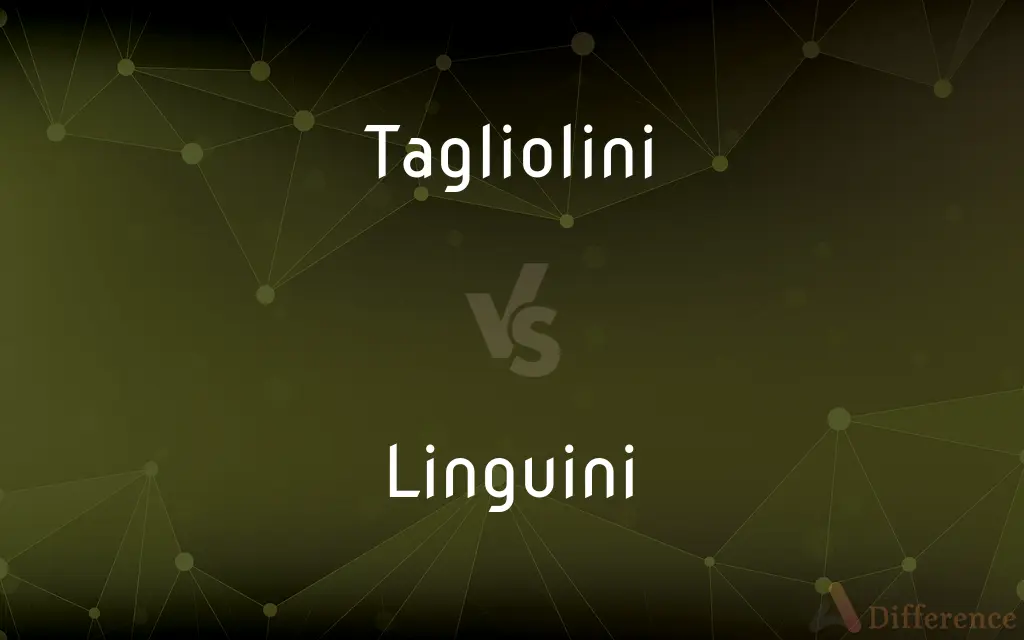Tagliolini vs. Linguini — What's the Difference?
By Tayyaba Rehman & Maham Liaqat — Updated on April 24, 2024
Tagliolini is a narrow, ribbon-like pasta typical in northern Italy, very thin and delicate, while linguini, slightly wider, is firmer and more versatile in various dishes.

Difference Between Tagliolini and Linguini
Table of Contents
ADVERTISEMENT
Key Differences
Tagliolini is traditionally egg-based and has a very thin, ribbon-like shape, ideal for light, creamy sauces. On the other hand, linguini, often made from durum wheat, is slightly thicker and holds up well with heavier, seafood-based sauces like the classic linguini with clams.
Tagliolini is often served in broths or with subtle sauces in northern Italy, accentuating its delicate texture. Whereas linguini is popular in more robust Italian dishes, its wider and flatter shape makes it suitable for capturing more sauce.
The preparation of tagliolini typically involves a quick cooking time due to its thinness, making it perfect for simple, quick meals. Conversely, linguini requires a slightly longer cooking time, which allows it to absorb flavors more robustly.
In terms of regional cuisine, tagliolini is a staple in the Piedmont and Emilia-Romagna regions, known for their refined and elegant dishes. Linguini, however, is more associated with the southern regions of Italy, especially along the coastal areas where seafood is plentiful.
Tagliolini is usually found in more specialized or regional Italian markets or restaurants. On the other hand, linguini is widely available and recognized, making it a staple pasta choice globally.
ADVERTISEMENT
Comparison Chart
Ingredients
Typically made with egg
Typically made without egg
Shape
Very thin, ribbon-like
Wider and flatter than tagliolini
Sauce Compatibility
Light, creamy sauces
Heavier, often seafood-based sauces
Cooking Time
Short due to thinness
Longer, absorbs flavors well
Regional Popularity
Northern Italy (Piedmont, Emilia-Romagna)
Southern Italy, especially coastal areas
Compare with Definitions
Tagliolini
Requires careful cooking to maintain its fine texture.
He carefully timed the tagliolini to ensure it was al dente.
Linguini
Often made from durum wheat and water, without egg.
The linguini maintained its firm texture throughout the meal.
Tagliolini
Known for its delicate and thin structure, often paired with light sauces.
Tagliolini complements the light garlic and olive oil dressing perfectly.
Linguini
A type of pasta similar to fettuccine but narrower and rounder.
Linguini with clam sauce is her favorite dish at the Italian restaurant.
Tagliolini
Commonly used in Italian broths or simple butter-based dishes.
For dinner, we had tagliolini in a clear, savory broth.
Linguini
Suitable for a variety of sauces, particularly rich seafood sauces.
They tossed the linguini in a thick tomato and basil sauce.
Tagliolini
A type of pasta resembling narrow ribbons, usually made from egg dough.
She served homemade tagliolini with a truffle sauce.
Linguini
Frequently used in dishes originating from southern Italy.
His specialty is linguini with a spicy Calabrian sausage sauce.
Tagliolini
Predominantly found in northern Italian cuisine, especially Piedmont.
In Piedmont, tagliolini is often served with a rabbit ragu.
Linguini
Requires a bit more cooking time than thinner pastas.
The linguini was boiled for ten minutes to reach perfect tenderness.
Tagliolini
Tagliolini (Italian pronunciation: [taʎʎoˈliːni]) is a type of ribbon pasta, long like spaghetti, roughly 2-3 mm wide, similar to tagliatelle, but thin like capellini. It is a traditional recipe in the Molise and Piedmont regions of Italy.
Linguini
Pasta in long, flat, thin strands.
Tagliolini
A kind of egg pasta with a ribbon shape, like tagliatelle but thinner.
Linguini
Alternative spelling of linguine
Linguini
Pasta in long slender flat strips
Common Curiosities
Which pasta is better for light sauces?
Tagliolini is better suited for light, delicate sauces due to its thin, delicate structure.
What is the main ingredient difference between tagliolini and linguini?
Tagliolini is usually made with eggs, whereas linguini is typically made from just durum wheat and water.
Can linguini be used for quick meals?
Yes, although it has a slightly longer cooking time than tagliolini, linguini can still be used for relatively quick pasta dishes.
Are both pastas available globally?
While both are available globally, linguini is more commonly found in a variety of markets and stores worldwide.
What type of dishes is tagliolini commonly used in?
Tagliolini is commonly used in broths and light, creamy sauce dishes.
Which pasta cooks faster?
Tagliolini cooks faster due to its thinner shape.
Which pasta is more traditional for a seafood feast?
Linguini is more traditional for seafood feasts, especially in southern Italian coastal regions.
Is linguini suitable for seafood dishes?
Yes, linguini is particularly well-suited for seafood dishes like linguini with clams or seafood marinara.
How does linguini absorb flavors compared to tagliolini?
Linguini absorbs flavors more robustly due to its thicker and denser structure.
Where is tagliolini most popularly used?
Tagliolini is most popular in northern Italy, particularly in regions like Piedmont and Emilia-Romagna.
What are typical sauces for tagliolini?
Typical sauces include light broths, butter, and truffle oil.
What makes linguini different in shape from tagliolini?
Linguini is wider and flatter, making it slightly thicker than the very thin tagliolini.
Can tagliolini be used with meat sauces?
Yes, while less common, tagliolini can be used with delicate meat sauces or in broths with meat.
Which pasta is typically more expensive?
Tagliolini might be slightly more expensive due to its association with regional, specialized Italian cooking.
Is linguini a good choice for vegetarian dishes?
Yes, linguini works well with a variety of vegetarian sauces, such as pesto or simple tomato sauce.
Share Your Discovery

Previous Comparison
Boat vs. Launch
Next Comparison
Frugal vs. ParsimoniousAuthor Spotlight
Written by
Tayyaba RehmanTayyaba Rehman is a distinguished writer, currently serving as a primary contributor to askdifference.com. As a researcher in semantics and etymology, Tayyaba's passion for the complexity of languages and their distinctions has found a perfect home on the platform. Tayyaba delves into the intricacies of language, distinguishing between commonly confused words and phrases, thereby providing clarity for readers worldwide.
Co-written by
Maham Liaqat













































